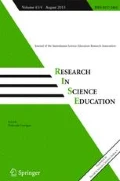Abstract
This study investigated whether and how peer collaboration facilitated students' problem solving in physics. A qualitative physics test was administered to two Secondary 6 (Year 12) classes, with half of the students in each class randomly assigned to take the test individually and the other half to work in dyads. The abilities of the individuals and dyads were matched such that there was no significant difference between their physics examination grades. The test results show that the dyads performed better than the individuals on each problem and the test as a whole. The rich collaborative talk of the dyads shows that peer collaboration provided students with experiences of co-construction and conflict that were conducive to successful problem solving. However, it was found that co-construction could lead to correct as well as wrong solutions and that conflict and co-construction could occur in the same instance rather than as separate activities. The study also found that students' success in problem solving depended not so much on their ability but on how they interacted and whether and how they invoked the relevant physics principles and strategies.
Similar content being viewed by others
References
Alexopoulou, E., & Driver, R. (1996). Small-group discussion in physics: Peer interaction modes in pairs and fours.Journal of Research in Science Teaching, 33(10), 1099–1114.
Arons, A. B. (1982). Phenomenology and logical reasoning in introductory physics course.American Journal of Physics, 50, 13–20.
Arons, A. B. (1997).Teaching introductory physics. New York, NY: John Wiley.
Chi, M. T. H., Feltovich, P. J., & Glaser, R. (1981). Categorisation and representation of physics problems by experts and novices.Cognitive Science, 5, 121–152.
Crook, C. (1994).Computers and the collaborative experiences of learning. London, UK: Routledge.
Damon, W., & Phelps, E. (1989). Critical distinction among three approaches to peer education.International Journal of Educational Research, 13, 9–19.
Finegold, M., & Mass, R. (1985). Differences in the processes of solving physics problems between good physics problem solvers and poor physics problem solvers.Research in Science and Technological Education, 3(1), 59–67.
Goodlad, S., & Hirst, B. (1989).Peer tutoring: A guide to learning by teaching. London, UK: Kogan Page.
Hamm, M., & Adams, D. (1992).The collaborative dimensions of learning Norwood, NJ: Albex.
Heller, P., & Hollabaugh, M. (1992). Teaching problem solving through cooperative grouping: Part 2: Designing problems and structuring groups.American Journal of Physics, 60, 637–644.
Heller, P., Keith, R., & Anderson, S. (1992). Teaching problem solving through cooperative grouping. Part 1: Group versus individual problem solving.American Journal of Physics, 60(7), 627–636.
Heller, P., & Reif, F. (1984). Prescribing effective human problem-solving processes: Problem descriptions in physics.Cognition and Instruction, 1, 177–216.
Huffman, D. (1997). Effects of explicit problem solving instruction on high school students' problem-solving performance and conceptual understanding of physics.Journal of Research in Science Teaching, 34(6), 551–570.
Krajcik, H. S., Simmons, P. E., & Lunnetta, V. N. (1988). A research strategy for the dynamic study of students' concepts and problem solving strategies using science software.Journal of Research in Science Teaching, 25(2), 147–155.
Larkin, J. H., McDermott, L. C., Simon, D. P., & Simon, H. (1980). Expert and novice performance in solving physics problems.Science, 208, 1335–1342.
Leonard, W. J., Dufresne, R. J., & Mestre, J. P. (1996). Using qualitative problem-solving strategies to highlight the role of conceptual knowledge in solving problems.American Journal of Physics, 64(12), 1495–1503.
Maloney, D. P. (1994). Research on problem solving: Physics. In D. L. Gabel (Ed.),Handbook of research on science teaching and learning (pp. 327–354). New York, NY: Macmillan.
Mason, L. (1998). Sharing cognition to construct scientific knowledge in school context: The role of oral and written discourse.Instructional Science, 26, 359–389.
McDermott, L. C. (1991). Milikan Lecture 1990: what we teach and what is learned—closing the gap.American Journal of Physics, 59, 301–315.
McDermott, L. C. (1993). Guest Comment: How we teach and how students learn—a mismatch?American Journal of Physics, 61, 295–298.
Mestre, J. P., Dufresne, R. J., Gerace, W. J., Hardiman P. T., & Tougher, T. S. (1993). Promoting skilled problem-solving behaviour among beginning physics students.Journal of Research in Science Teaching, 30, 307–317.
Piaget, J. (1985).The equilibration of cognitive structure. Chicago, IL: Chicago University Press.
Scott, P. H. (1995, April). Social interactions and personal meaning making in secondary science classrooms. Paper presented at the annual meeting of the American Educational Research Association, San Francisco.
Sharon, S. (1990).Cooperative learning: Theory and research. New York, NY: Praeger.
Tao, P. K., & Gunstone, R. F. (1999). Conceptual change in science through collaborative learning at the computer.International Journal of Science Education, 21(1), 39–57.
Tao, P. K., & Mak, S. Y. (1987). Pupils' qualitative reasoning ability in solving physics problems.Educational Research Journal, 2, 78–85.
Vygotsky, L. S. (1962).Thought and language. Cambridge, MA: MIT Press.
Author information
Authors and Affiliations
Corresponding author
Rights and permissions
About this article
Cite this article
Tao, PK. Peer collaboration in solving qualitative physics problems: The role of collaborative talk. Research in Science Education 29, 365–383 (1999). https://doi.org/10.1007/BF02461599
Issue Date:
DOI: https://doi.org/10.1007/BF02461599



